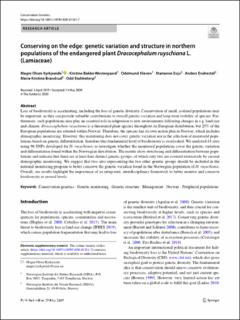Conserving on the edge: genetic variation and structure in Northern populations of the endangered plant Dracocephalum ruyschiana L. (Lamiaceae)
Kyrkjeeide, Magni Olsen; Westergaard, Kristine Bakke; Kleven, Oddmund; Evju, Marianne; Endrestøl, Anders; Brandrud, Marie Kristine; Stabbetorp, Odd Egil
Peer reviewed, Journal article
Published version

Åpne
Permanent lenke
https://hdl.handle.net/11250/2661606Utgivelsesdato
2020Metadata
Vis full innførselSamlinger
- Publikasjoner fra CRIStin - NINA [2364]
- Scientific publications [1392]
Originalversjon
10.1007/s10592-020-01281-7Sammendrag
Loss of biodiversity is accelerating, including the loss of genetic diversity. Conservation of small, isolated populations may be important, as they can provide valuable contributions to overall genetic variation and long-term viability of species. Furthermore, such populations may play an essential role in adaptation to new environments following changes in e.g. land-use and climate. Dracocephalum ruyschiana is a threatened plant species throughout its European distribution, but 25% of the European populations are situated within Norway. Therefore, the species has its own action plan in Norway, which includes demographic monitoring. However, this monitoring does not cover genetic variation nor is the selection of monitored populations based on genetic differentiation, therefore this fundamental level of biodiversity is overlooked. We analyzed 43 sites using 96 SNPs developed for D. ruyschiana, to investigate whether the monitored populations cover the genetic variation and differentiation found within the Norwegian distribution. The results show structuring and differentiation between populations and indicate that there are at least four distinct genetic groups, of which only two are covered extensively by current demographic monitoring. We suggest that two sites representing the two other genetic groups should be included in the national monitoring program to better conserve the genetic variation found in the Norwegian population of D. ruyschiana. Overall, our results highlight the importance of an integrated, interdisciplinary framework to better monitor and conserve biodiversity at several levels. Keywords Conservation genetics · Genetic monitoring · Genetic structure · Management · Norway · Peripheral populations
